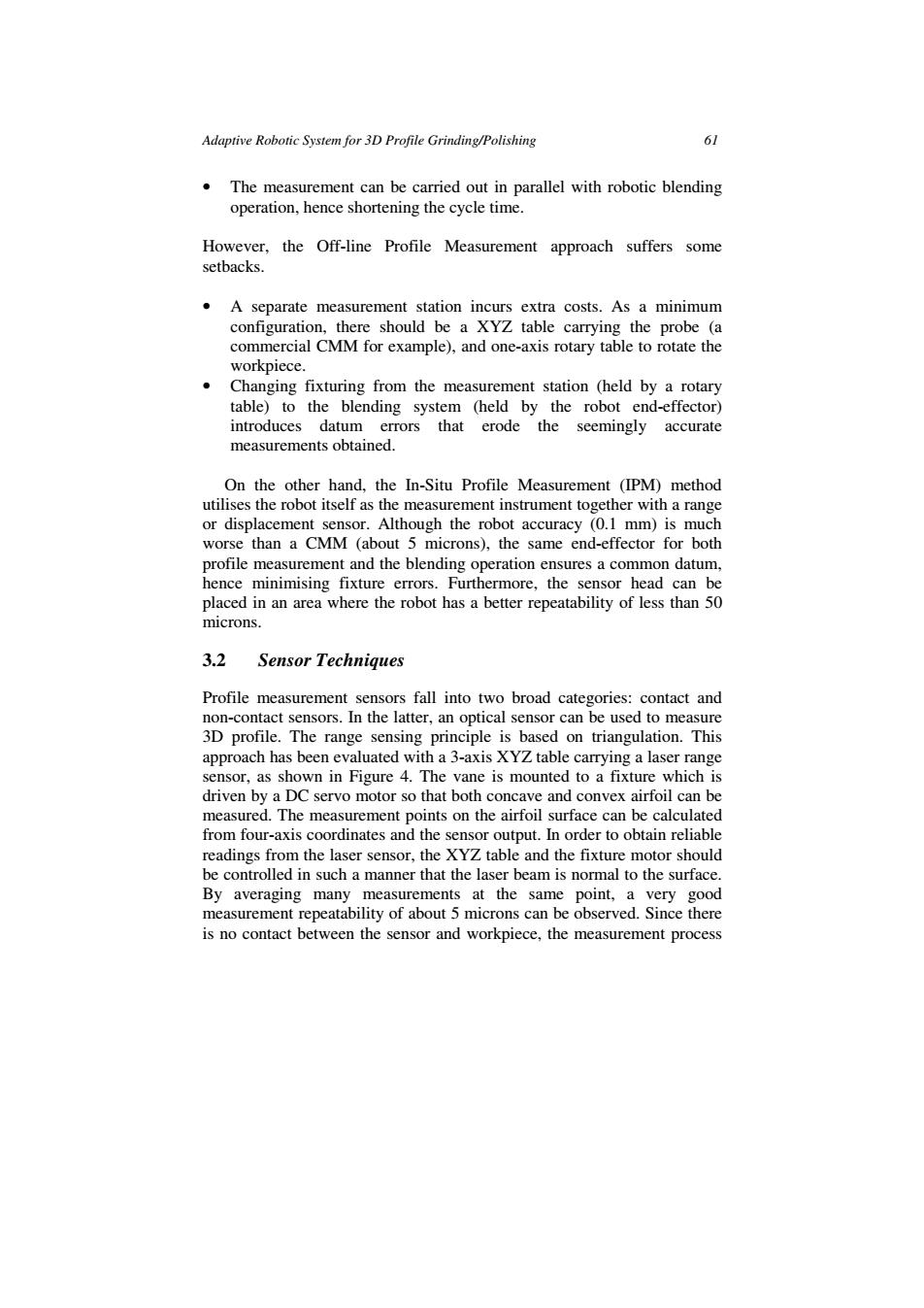正在加载图片...

Adaptive Robotic System for 3D Profile Grinding/Polishing 61 The measurement can be carried out in parallel with robotic blending operation,hence shortening the cycle time. However,the Off-line Profile Measurement approach suffers some setbacks. .A separate measurement station incurs extra costs.As a minimum configuration,there should be a XYZ table carrying the probe (a commercial CMM for example),and one-axis rotary table to rotate the workpiece. Changing fixturing from the measurement station (held by a rotary table)to the blending system (held by the robot end-effector) introduces datum errors that erode the seemingly accurate measurements obtained. On the other hand,the In-Situ Profile Measurement (IPM)method utilises the robot itself as the measurement instrument together with a range or displacement sensor.Although the robot accuracy (0.1 mm)is much worse than a CMM (about 5 microns),the same end-effector for both profile measurement and the blending operation ensures a common datum, hence minimising fixture errors.Furthermore,the sensor head can be placed in an area where the robot has a better repeatability of less than 50 microns. 3.2 Sensor Techniques Profile measurement sensors fall into two broad categories:contact and non-contact sensors.In the latter,an optical sensor can be used to measure 3D profile.The range sensing principle is based on triangulation.This approach has been evaluated with a 3-axis XYZ table carrying a laser range sensor,as shown in Figure 4.The vane is mounted to a fixture which is driven by a DC servo motor so that both concave and convex airfoil can be measured.The measurement points on the airfoil surface can be calculated from four-axis coordinates and the sensor output.In order to obtain reliable readings from the laser sensor,the XYZ table and the fixture motor should be controlled in such a manner that the laser beam is normal to the surface. By averaging many measurements at the same point,a very good measurement repeatability of about 5 microns can be observed.Since there is no contact between the sensor and workpiece,the measurement processAdaptive Robotic System for 3D Profile Grinding/Polishing 61 • The measurement can be carried out in parallel with robotic blending operation, hence shortening the cycle time. However, the Off-line Profile Measurement approach suffers some setbacks. • A separate measurement station incurs extra costs. As a minimum configuration, there should be a XYZ table carrying the probe (a commercial CMM for example), and one-axis rotary table to rotate the workpiece. • Changing fixturing from the measurement station (held by a rotary table) to the blending system (held by the robot end-effector) introduces datum errors that erode the seemingly accurate measurements obtained. On the other hand, the In-Situ Profile Measurement (IPM) method utilises the robot itself as the measurement instrument together with a range or displacement sensor. Although the robot accuracy (0.1 mm) is much worse than a CMM (about 5 microns), the same end-effector for both profile measurement and the blending operation ensures a common datum, hence minimising fixture errors. Furthermore, the sensor head can be placed in an area where the robot has a better repeatability of less than 50 microns. 3.2 Sensor Techniques Profile measurement sensors fall into two broad categories: contact and non-contact sensors. In the latter, an optical sensor can be used to measure 3D profile. The range sensing principle is based on triangulation. This approach has been evaluated with a 3-axis XYZ table carrying a laser range sensor, as shown in Figure 4. The vane is mounted to a fixture which is driven by a DC servo motor so that both concave and convex airfoil can be measured. The measurement points on the airfoil surface can be calculated from four-axis coordinates and the sensor output. In order to obtain reliable readings from the laser sensor, the XYZ table and the fixture motor should be controlled in such a manner that the laser beam is normal to the surface. By averaging many measurements at the same point, a very good measurement repeatability of about 5 microns can be observed. Since there is no contact between the sensor and workpiece, the measurement process